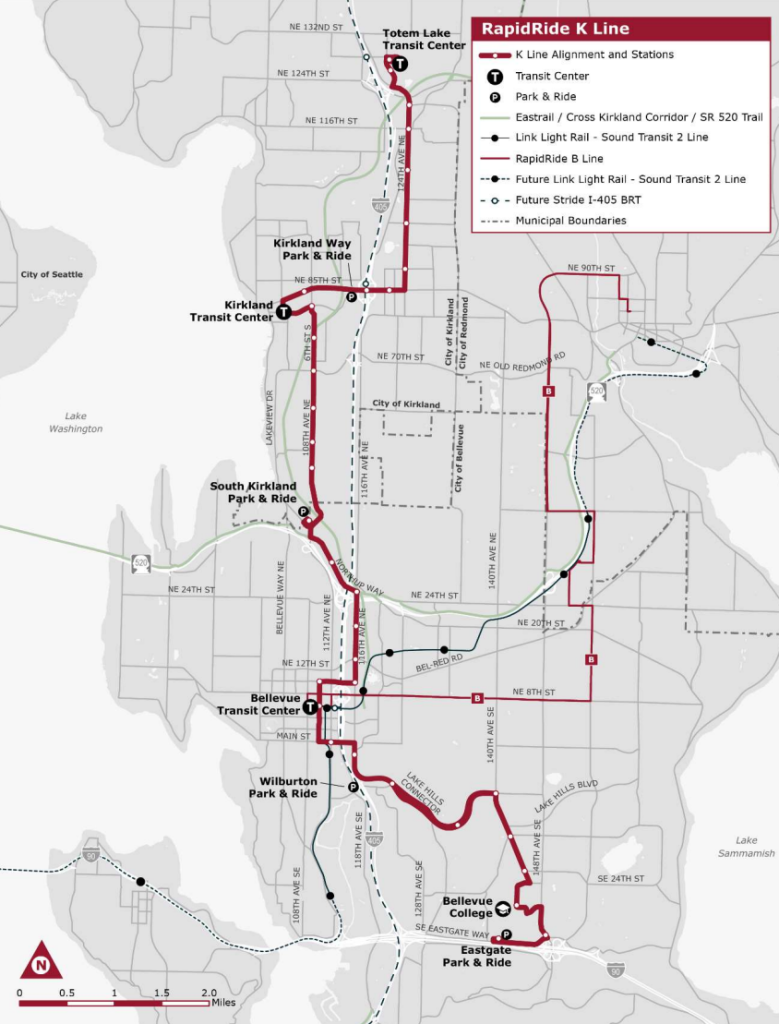
The King County Council voted unanimously Tuesday to endorse a preferred route for Metro’s next RapidRide bus project on the Eastside, the K Line between Kirkland’s Totem Lake and Eastgate. The 16-mile route would combine portions of the existing Routes 239, 245, 250, 255, and 271 with service every 10 minutes during peak hours and 15 minutes off-peak, connecting some of the fastest-growing areas in the region with light rail and other major hubs.
With a $105.9 million budget, getting the K Line fully funded remains the biggest obstacle in front of the county, with over half of those dollars assumed to come from federal sources. The selection of a locally preferred alternative (LPA), endorsed by both Kirkland and Bellevue city government, means the project can advance into full design and get into the queue for a Federal Transit Administration (FTA) grant.
Whether such a grant will be forthcoming remains an open question, as the Trump administration has been openly hostile to transit. The current schedule calls for the K Line to open by 2030.
The LPA also includes a set of 35 proposed station pairs, along with speed and reliability improvements intended to produce a 25% decrease in end-to-end travel time, compared to bus trips that would happen without the project at the time it opens. Capital improvements like business access and transit (BAT) lanes, signal priority, and station consolidation are expected to save at least 22 minutes on the K Line’s segment in Kirkland, and more than 23 minutes through Bellevue.

“This has been a long time coming,” King County Councilmember Claudia Balducci said ahead of Tuesday’s vote. “We’ve been planning for the K Line in a number of ways for a very long time, and hitting this point where the council gives our approval to move into the next phase, it’s a really exciting and important step forward, because we’re setting the stage for a new RapidRide corridor.”
First proposed as one potential route for RapidRide expansion in 2017, work on the K Line was indefinitely paused in 2020 in response to pandemic-related budget shortfalls. It was only restarted again due to funding allocations from the King County Council, work spearheaded by Balducci.
Some of the proposed elements of the K Line have already been prompting controversy — specifically within Kirkland’s Houghton neighborhood. Property owners and nearby residents have raised concerns about plans to add BAT lanes along a section of 108th Avenue NE that experiences significant traffic congestion. Several months ago, yard signs started popping up telling passersby to email city and county officials telling them “no bus lanes on 108th,” but ultimately the LPA was not watered down. Metro will instead study all design options through Houghton that will allow it to achieve its speed and reliability goals.

This spring, the Kirkland City Council did communicate its desire to see Metro closely analyze the options along 108th, and noted that support from Kirkland could be pulled if leaders felt that the agency wasn’t doing enough to minimize or mitigate impacts.
“The City is interested in a cost/benefit analysis of these projects as part of that evaluation,” a memo approved by the Kirkland Council in March stated. “The City is also interested in exploring whether the BAT lanes could be restricted to buses for certain parts of the day but become available as general purpose lanes outside of those hours. Finally, the City recognizes both the northbound and southbound set of investments along 108th Ave NE/6th Street South and NE 68th Street will likely impact private residences and businesses that front the arterial. The City support is contingent on any design options minimizing these private property impacts as much as possible, and that any impacts will be fully and appropriately mitigated.”

“There are some homes that are right up against the property lines along this very busy road in Houghton and a very short extension of the BAT lane could easily result in having to take whole homes and properties — or not — and I would like us to look very carefully at trying to limit the impacts,” Balducci said this week.
Bus ridership on the Eastside is lagging behind other parts of the region and has been slow to recover from pandemic losses. The K Line is seen as a big step forward for transit in Kirkland in particular, which will not see light rail serving its downtown as part of the Sound Transit 3 package.
“The rapid K Line is a once-in-a-generation investment to provide frequent, fast, and reliable service between the Kirkland and Bellevue communities, that will connect the Eastside to major regional transit network such as light rail, future Stride BRT service on I-405, and RapidRide B Line in Redmond,” Kirkland Mayor Kelli Curtis said. “Within Kirkland, the K Line route will connect diverse community groups and visitors to our two regionally designated growth centers, major employers, and Kirkland’s desirable amenities.”
Construction on the K Line is set to start in 2028, assuming that the project is able to assemble full funding. Elsewhere in the RapidRide network, construction is well underway on the RapidRide J between Downtown Seattle and the U District, and is poised to start soon on the RapidRide I between Renton and Auburn. Both are slated to open in 2027. Seattle’s next RapidRide, the R Line between Downtown and Rainier Beach, is further behind the K Line in terms of planning, despite plans to open that line just a year later in 2031.
Ryan Packer has been writing for The Urbanist since 2015, and currently reports full-time as Contributing Editor. Their beats are transportation, land use, public space, traffic safety, and obscure community meetings. Packer has also reported for other regional outlets including BikePortland, Seattle Met, and PubliCola. They live in the Capitol Hill neighborhood of Seattle.

